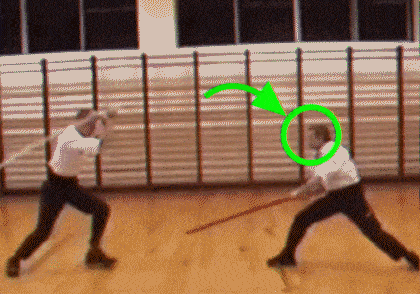
-Traditional symmetrical, 2-way, loopable form for outnumbered fencing with a hit to the side at one hand.
Meio trapalhão…
Apontamentos sobre o jogo do pau português. -Traditional Portuguese staff fencing art.

-Traditional symmetrical, 2-way, loopable form for outnumbered fencing with a hit to the side at one hand.
Meio trapalhão…
O moinho, ao contrário do jogo livre, é uma sequencia repetida e predeterminada de ataques, em que são praticadas as transições entre defesa e contra ataque. Como neste exercício, já é conhecida pelos praticantes a sequencia de ataques, estes podem ser feitos com alguma segurança, aumentando a velocidade e praticando assim as transições.
EN:
Whe
“windmill” drill in jogo do pau is different to freeplay, in that it is a pre arranged looping sequence of parry and counter attacks. Because the sequence is known by the fencers, this exercise can be done with some safety, and the speed can this way be higher, to practice the transition from parry to counter attack.

Sequencia de 6 defesas e contra ataques / Sequence of 6 parry and counters
PT:
Como podemos ver na imagem, o descolamento do corpo em jogo livre deve ser constante, havendo sempre um ajuste da distancia na defesa, sendo que o ataque é sempre realizado para bater. O jogador que ataca, avança para chegar ao alvo, mas o que defende recua, mantendo-se seguro. Esta não é uma regra absoluta, pois quem defende pode conseguir defender no lugar ou mesmo a avançar, mas este deslocamento base, permite uma maior segurança, e é o mais comummente utilizado.
Quando se vê o video normalmente, pode parecer que as varas so tocam uma na outra e que se esta a atacar para o ar. Isso seria verdade se não houvesse deslocamento, mas neste caso podemos ver que os ataques são feitos para o corpo, e é o constante deslocamento que permite uma defesa segura.
Note que deslocamento do corpo não é apenas deslocamento do pé, é possível mover o pé sem quase mexer o corpo, mas o que se quer aqui é deslocar tanto o corpo como o pé.
EN:
As we can see in the image, the movement of the body is constant in traditional freeplay, there is always an adjustment by the defender, and the attack is done to reach him. The fencer that attacks moves forward to reach the target, but the defender retreats back, keeping a safe distance. This is not a “rule of the game”, the defender could stay in place or even move forward when parrying if he had the skill for that, but this displacement allows more safety and is the most commonly used.
When the video is played normally it might look like the fencers are striking out of range and only hitting to the staffs. That would be true if they didn’t move their body and just stayed in place hitting out of distance, but this is not the case, since the strikes are made to the target and the body displacement of the defender is what creates the safe distance.
Note that body displacement is not the same as just footwork, it is possible to move the feet without barely moving the body, that is not what we see here, what is done in jogo do pau is the displacement of the body as much as the feet.

Nuno Russo e Luis Preto
A técnica de Bastão de combate da Esgrima Lusitana deriva da utilização do varapau a duas mãos, aperfeiçoada pelo mestre Nuno Russo, que podemos ver no clip.
Jogo do pau baton fencing technique derived from traditional two handed long staff, developed and perfected by master Nuno Russo on the left of the clip.

PT:
O vira costas é uma técnica essencial no combate contra vários adversários estando cercado. Pois este ataque, ao fazer girar o corpo numa volta, transfere essa energia horizontal para a arma, que abrange todas as direcções. No entanto, apesar desta multidirecção do ataque, esta volta não é feita de forma descontrolada, mas sim direcionada para um dos lados, utilizando a tactica de gestão de espaço. Com cuidado podemos ver no clip, que o puxador se desloca sempre numa direcção, quando roda, e que antes de finalizar o ataque, a sua cara já está virada para onde vai atacar, sendo uma pancada feita com uma tomada de decisão conscientemente quanto ao alvo, com a vantagem extra, de a rotação da vara em torno do corpo oferecer alguma protecção.
EN:
The “turnaround” strike is an essential technique on combat against multiple opponents, specially when surrounded. With the turn of the body, the energy is transferred horizontally to the weapon, affecting multiple directions and opponents all around. however, this multidirectionality of the move does not mean it can be made without thinking. It is directed at a specific direction, with the tactic of space management characteristic of this fighting situation. With attention to the clip we can see that the fencer always moves in a direction, when he rotates, and that before he finishes the attack, his head turns first to face the direction of the attack, so he can make a conscious decision to where he is targeting his strike.

Sai da frente!

Bater atrás a uma mão. // Beating back at one hand.
Para afastar o adversário que está nas costas, ameaça-se com um ataque por cima, mas ataca-se baixo aos membros inferiores largando a uma mão, para forçar o adversário a recuar. Com a continuação do movimento de rotação do corpo, volta-se a cair ao adversário inicial com varrimenta.
To scare away the opponent on the back, threaten with a high strike, but release at one hand and strike to the lower body to force the opponent back. Then with the continuation of the rotation of the body, turn to the initial opponent with a sweep.